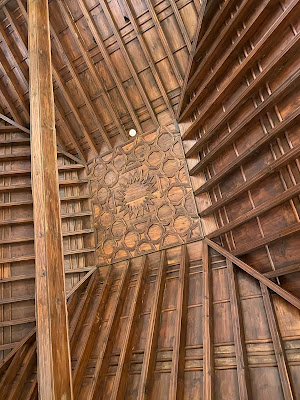Artesonado Mudéjar
(Es)
El artesonado mudéjar se refiere a toda techumbre con decoración de madera, que resuelve los problemas estructurales de los edificios. Se encuentran fundamentalmente en la arquitectura mudéjar (estilo artístico que se desarrolló en los reinos cristianos de la península ibérica, es fundamentalmente decorativa, introduce nuevas soluciones) y musulmana.
En las islas canarias, los encontramos sobre todo en las iglesias, palacios o casas particulares.
Recordar que todo este tipo de decoración llegó a las islas con los colonos después de la conquista, había que construir rápido y una de las mejores opciones era el artesonado, ayudado por la madera de tea que se encontraba en la isla.
Artesonado mudéjar
(En)
The Mudejar coffered ceiling refers to any roof with wooden decoration, which solves the structural problems of buildings. They are found fundamentally in Mudejar architecture (an artistic style that developed in the Christian kingdoms of the Iberian Peninsula, it is fundamentally decorative, it introduces new solutions) and Muslim.
What is the Artesón? It is the concave, polygonal, molded and ornamented construction element that is usually made of wood (mostly), but also of stone or other materials, which arranged in series form the coffered ceiling (it is better to see it, since it seems more complicated when explained).
In the Canary Islands, we find them above all in churches, palaces or private homes,
Remember that all this type of decoration arrived on the islands with the settlers after the conquest, it had to be built quickly and one of the best options was the coffered ceiling, helped with the tea wood found on the island.
A total of 89 Mudejar buildings are preserved in the #Canary Islands, the majority in #Tenerife (55). But they are also found in #LaPalma (27), where there are the oldest Mudejar coffered ceilings in the Canary Islands, dating from the 16th century; #GranCanaria (2); #Lanzarote (2); #Fuerteventura (2); #LaGomera (1)





No hay comentarios:
Publicar un comentario